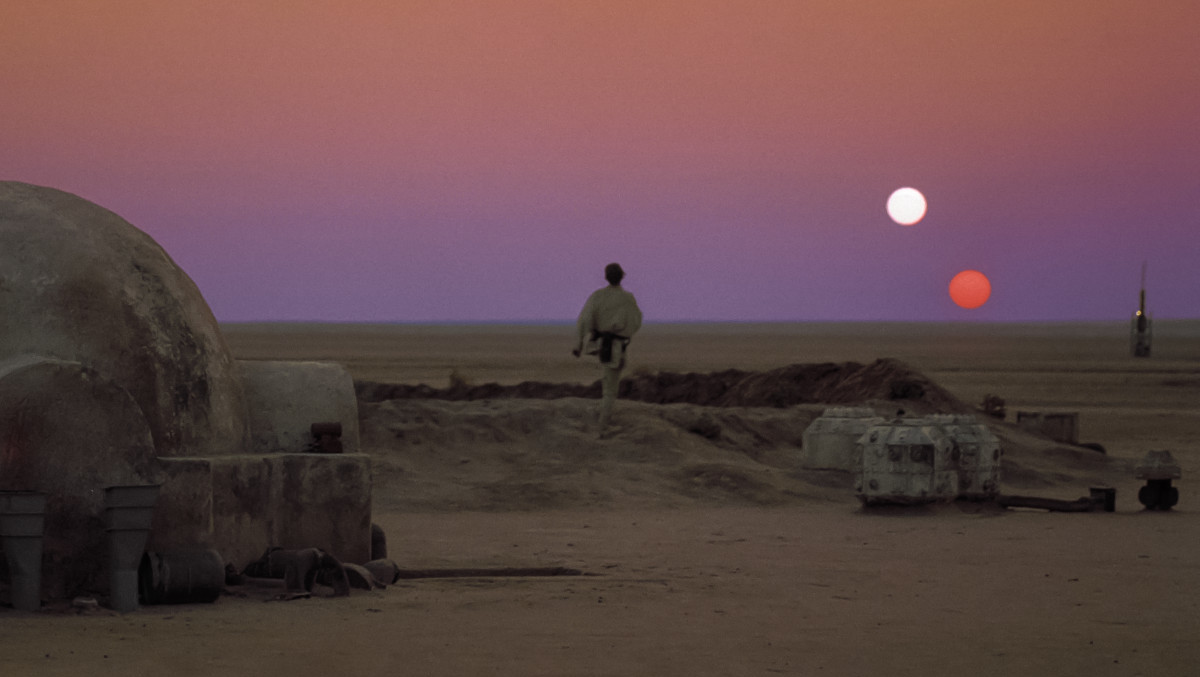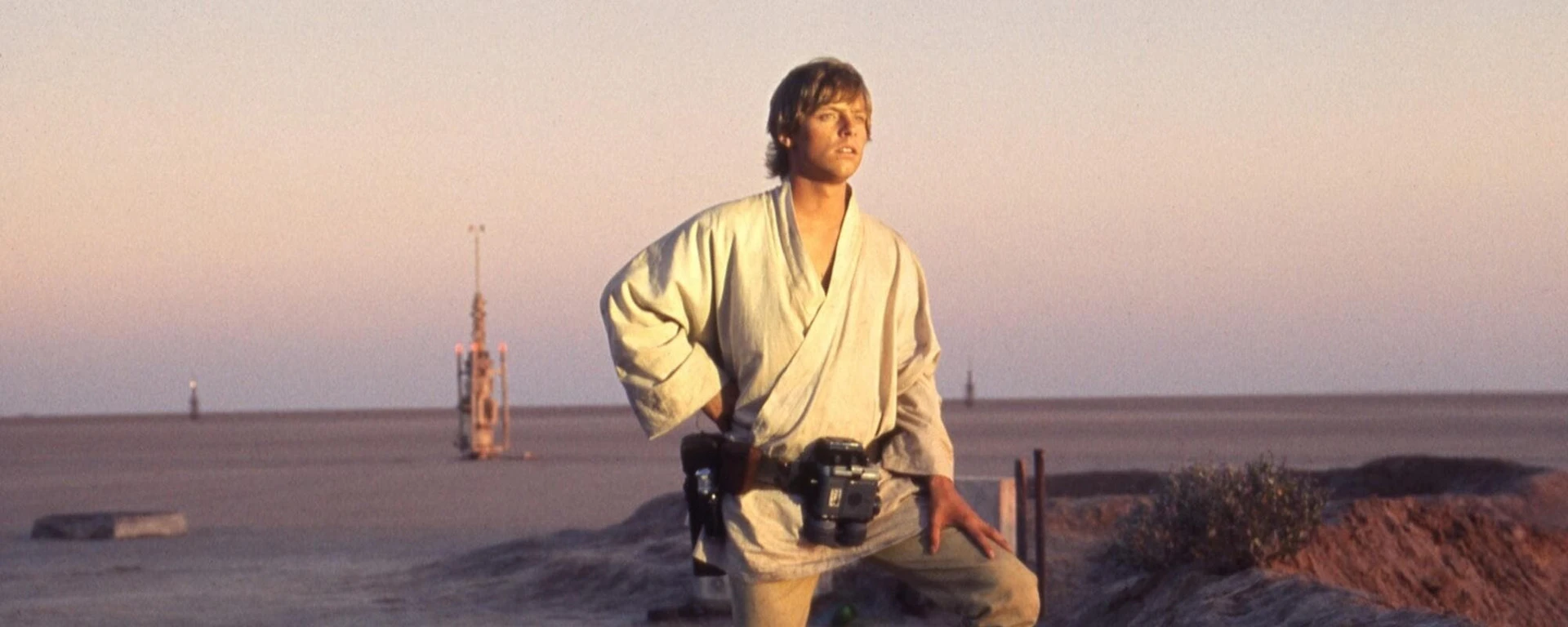The Force Awakens arrives in theatres six months from today – so what better excuse is there to launch a series of Star Wars-themed posts between now and when the film opens on 17 December? To kick things off, let’s go back to where it all began: 1977’s Star Wars – Episode IV: A New Hope (or just plain Star Wars, if you’re a purist). Specifically, let’s unpack why the binary sunset scene is one of the most iconic moments in Star Wars (and cinema) history, and consider how it could influence J.J. Abrams’ upcoming franchise relaunch.
On the face of it, the binary sunset scene – which sees a young, frustrated Luke Skywalker watch as the twin suns of his homeworld, Tatooine, set – might not seem like such a big deal. It’s incredibly brief (clocking in at under a minute), there’s no dialogue, and nothing really happens. Sure, it’s easy to appreciate the visuals on display. Gilbert Taylor’s cinematography is gorgeous, and the optical effects used to realise the otherworldly sunset itself still hold up well in a post-CGI era. But it takes more to make a classic scene than just dazzling imagery – so what makes the binary sunset so special?
Well, first up, this scene does a lot to establish Star Wars’ tone.
An overlooked element of the franchise’s appeal is that it takes the often cold, unrelatable trappings of the sci-fi genre and transforms them into something warm and identifiable. Under the direction of series creator George Lucas, concept artist Ralph McQuarrie and production designers John Barry and Roger Christian created a “lived in” environment which – with its dented vehicles, patched-up clothes, and scuffed-up corridors – was more like our own world than the shiny, unrecognisably futuristic locales in vogue in sci-fi at the time. Star Wars may be set “a long time ago in a galaxy far, far away”, but it’s still a place we can recognise, and crucially, it’s populated by people we can relate to.
Nothing embodies this better than the binary sunset scene. Sure, Luke is wearing a weird kimono-style outfit and he’s gazing at the kind of astronomical phenomena typically only witnessed by someone with severe cataracts – but what could be more relatable than the image of a wide-eyed teen dreaming about the future as the day winds down? That’s what makes these 36 seconds of footage so important to the wider Star Wars saga: it gets us in the right frame of mind for a story that’s as much a coming-of-age tale as it is a space opera. And it helps us look past the starships and lightsabers (the awesome, awesome lightsabers) and become emotionally invested in Luke and his journey.

And that’s another thing the binary sunset scene does so well: it effectively and economically sets up Luke’s character arc in A New Hope and its sequels The Empire Strikes Back and Return of the Jedi, as he transitions from farm boy to Rebel hero to Jedi Knight. Up till this point in A New Hope, our opinion of Luke is that he’s a good-natured kid… but he’s also a bit of whiner. So, for us to invest in Luke as our main protagonist, we really need to understand where he’s coming from and why he’s prone to the odd bout of bitching – aside from the fact that he’s a teenager – otherwise, we’re not going to care about his heroic struggles later.
Fortunately, the binary sunset clearly communicates the underlying cause for Luke’s angst in only a few fleeting frames, by tapping into emotions we can all empathise with. Before the scene starts, we already know that Luke is desperate to leave his uncle and aunt’s farm in search of adventure. Essentially, he’s most of us at that age: eager for our adult life to begin and frustrated that it still hasn’t. So, when Luke stomps across the barren desert plains as the scene starts, we’re already starting to feel for the kid and his situation.
Then, as the suns slowly begin to sink in the evening sky, and Luke gazes toward the horizon, his yearning for something more becomes downright palpable. The wannabe fighter pilot squints off into the distance – almost as if he can glimpse his exciting future, just out of reach – and we’re not seeing him as a petulant teen anymore, but as the dreamer he really is. And at long last, we get him. From here on out, we can forgive Luke for the occasional juvenile outburst – because why shouldn’t we? Who hasn’t had at least one moment in their life when they longed to do what they felt in their bones they were meant to do with their life? Or suffered from the crushing feeling that their present situation will never change?

Obviously, Mark Hamill deserves props for his performance as Luke in the binary sunset scene. He does a fine job of capturing the mixture of hopefulness and anguish this moment requires without uttering a single word. Ultimately, though, John Williams’ score is what really sells this character beat and makes the scene work overall. The legendary composer drops a musical motif, “The Force Theme”, in this scene that’s so powerful the binary sunset scene – heck, the entire Star Wars saga – wouldn’t be the same without it.
The sense of impending destiny that Williams imbues the “The Force Theme” with is nothing short of uncanny. As it plays here, we (like Luke) know we’re on the cusp of something amazing, just waiting to happen. Best of all, this sentiment swells within the music as Luke peers towards the sunset, then subsides as he looks away, evoking our young would-be hero’s inability to realise this destiny, and the disappointment he suffers as a result. Unsurprisingly, Lucas and Williams would later run back variations of “The Force Theme” in subsequent installments, and it’s arguably the third most iconic Star Wars motif, behind the main title and the Imperial March.

So, the binary sunset scene clearly looms large over Star Wars’ past – but how will it impact its future? Given it’s among the most iconic scenes in the saga, will director J.J. Abrams reflect its influence in The Force Awakens? While it’s hard to say for certain at this stage, honestly, I’ll be shocked if he doesn’t. Indeed, given The Force Awakens appears to intentionally ape the aesthetic and tone of A New Hope – its fresh-faced protagonist and her desert wasteland home dominated last year’s teaser trailer – Abrams will likely evoke the spirit of the binary sunset scene at some point in the movie, and may even work in direct visual and audio nods to one of the franchise’s most important moments. But we’ll just have to wait until December to find out!
Agree? Disagree? Let me know in the comments below or on Twitter or Facebook!

Disney ruined Luke. The Luke of the EU is the true character. Not a hiding coward who gave up.
LikeLike
I couldn’t agree more about the Binary Sunset scene. It’s simplistic, poignant & speaks volumes in the 35 seconds of screen time. the sense of longing that Luke feels for something greater than his desert existence really sets the tone for the rest of the film
LikeLiked by 1 person
Thanks Patricia!
LikeLike